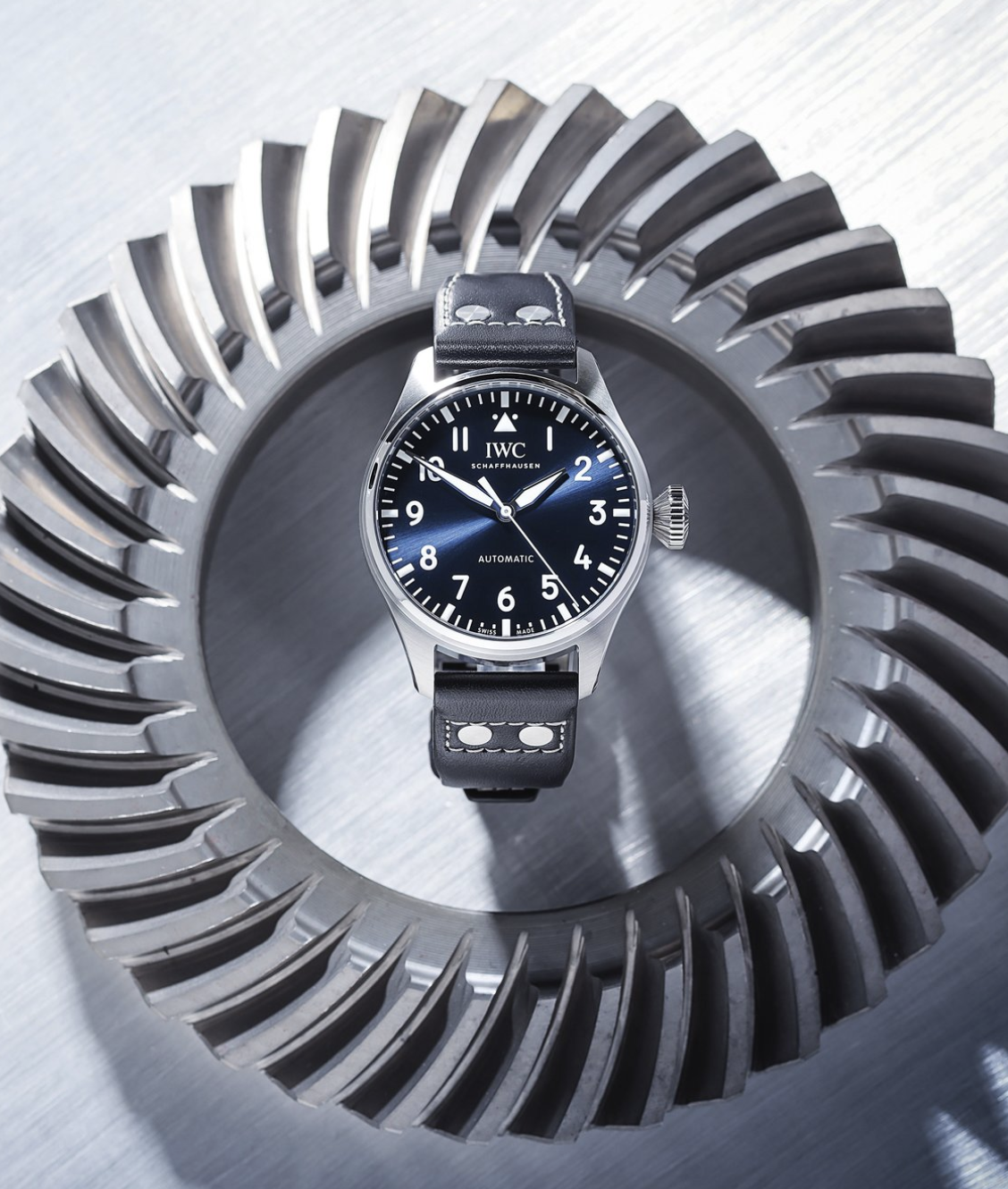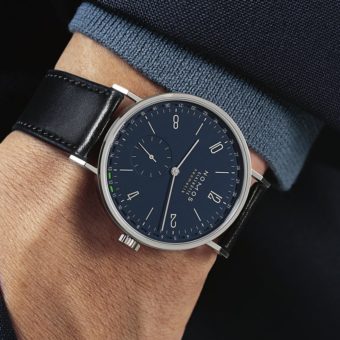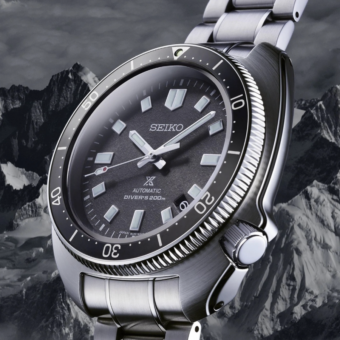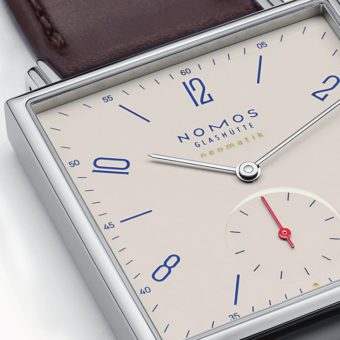This article was originally published in the March/April 2022 Issue of the WatchTime print magazine. Photos by Marcus Krüger.
IWC reduced the size of its iconic Big Pilot’s Watch by 3 mm, cleaned up the dial and installed a new in-house movement. Does this innovative model make the grade? We took it apart to find out.

The size of a watch can be viewed as relative. Aside from diameter and height, wrist size also varies considerably from person to person. Then add the consideration of social conventions and cultural differences, which are subject to change over time. For example, in the 1940s, some men’s watches measured only 31 mm in diameter. The smaller and thinner the watch, the more elegant it was. The large pilots’ watches built by IWC and other brands like A. Lange & Söhne beginning in 1940, which measured 55 mm across, must have looked as monstrously large as the clocks worn on a chain around the neck of Public Enemy rapper Flavor Flav in the 1980s. At that time, pilots’ watches weren’t intended to be a fashion statement, but simply a reflection of size following the functional requirements for military pilots and air reconnaissance officers. As with the IWC Portugieser, only a pocketwatch movement could achieve the necessary precision, which required a sufficiently large case to house it. The size and the offset central seconds hand ensured optimum legibility.
Since the 1990s, the trend for larger wristwatches has surged. When IWC reissued the Big Pilot’s Watch in 2002, the 46-mm diameter seemed large but definitely wearable for the daring. IWC has kept the watch’s size but offered a number of subtle revisions to the dial design. For the past few years, watch enthusiasts have been turning toward smaller watches again. And in 2021, IWC responded with the Big Pilot’s Watch 43, our test watch, a smaller version of the original.

Is this new model large enough to continue the icon’s story? This brings us back to the notion of relative size. This watch has had a date indication since 2002, which was considered essential at the time, as well as a power-reserve indicator. IWC was justifiably proud of the watch’s 7-day power reserve, even if this display is not necessarily essential for an automatic watch. With the new model, IWC has dispensed with both indications, and the uncluttered dial gives the watch a larger feel. Watch enthusiasts have recently come to prefer omitting the date in favor of a cleaner design. After all, you can always find the date on your smartphone, laptop or tablet. It’s no longer indispensable. And the power-reserve display has become superfluous, with the new in-house movement that stores energy up to 60 hours. The dial design is much more like its predecessor from 1940 in its symmetry and simplicity, especially in the version with the matte black dial. The stately conical turnip-style crown adds to the overall impression of size, which was not reduced true to scale, but like the numerals and hands was designed to create a harmonious image. And that was truly successful.
Our test watch looks more elegant with the blue dial with sunburst finish and the matching blue leather strap, almost like an air force officer in dress uniform. But we like both versions almost equally.
After determining that the Big Pilot’s Watch 43 is a worthy variant of the original, we opted to disassemble the watch completely and, like aircraft maintenance, subject every part to a visual inspection.

First, our local master watchmaker removed the threaded caseback. Even through the crystal caseback, the beautiful 82100 caliber reveals much of its technology with its skeletonized rotor and automatic bridge. The oscillating weight is a small work of art with relief engraving, sunburst finish, polished edges, and gold “Probus Scafusia” medallion, which promises tried and true products from Schaffhausen. Once removed, you can see the circular Côtes de Genève finish on the bridges, the perlage on the mainplate, the gold highlighted engraving, and the polished edges. Even the barrel has a machined sunburst finish.
A specialty of the IWC brand is the dualpawl winding mechanism developed by former head designer Albert Pellaton. It is composed of low-wear pawls and wheel made of black ceramic as well as the brushed finish Pellaton rocker and large ruby runners. The ensemble works this way: an eccentric disk beneath the rotor moves the rocker via two ruby runners; the two pawls then turn the wheel to wind the barrel. The movement can achieve a maximum power reserve of 60 hours. This is sufficient for the best possible scenario: taking your watch off on Friday evening and putting it back on Monday morning without it stopping.

The movement is regulated elegantly by adjusting four screws with square heads on the balance wheel, thus allowing the hairspring to breathe freely. An Incabloc shock absorber provides the springy support of the balance wheel. Disassembling the remaining bridges reveals that the components are decorated only where they are visible. Undersides and components that cannot be seen when the watch is fully assembled are undecorated. Even some minor scratches from assembly were apparent, but we took into account that our test watch was a pre-production model.
Another special feature became visible after further disassembly. The third wheel is seated in a ceramic block within the mainplate rather than a round jewel. This unusual design is said to function just as well. Overall, the large movement is structured to be service-friendly. There are a limited number of screw sizes, and the modules and bridges simplify assembly and servicing. All components have generous dimensions.
From a functional standpoint, the movement is convincing. IWC has concentrated its efforts on the visible portion, but does more than some other manufacturers. The rotor and bridges are designed to provide a satisfying view of the mechanism, and what you can see is clean and decorated with a variety of finishes. That makes it easy to overlook the lack of finishes on inaccessible places.

And how did our test watch run on the timing machine? Values for the individual positions are somewhat scattered but the average daily deviation was very small at -0.3 seconds.
Positive results are also reported from the operational side. It is simple to handle. The large, grooved crown is easy to unscrew and pull to set the time. No date indication means there is only one position for the crown. In combination with the stop-seconds mechanism, this greatly simplifies the setting procedure.
One problem with the 46-mm Big Pilot’s Watch, which continues to be available, is that the large turnip-style crown can press uncomfortably into the back of your hand. This is less of a problem with the new 43-mm version. Here the crown only touches the back of your hand with extreme wrist movements. This isn’t a problem for daily wear, but it’s a good idea to take the watch off before doing your morning pushups.

The simple folding clasp has a long inner bar that may press uncomfortably against your wrist. Thanks to the quick-change system, the stiff new strap can be easily attached the other way around, including the clasp. Although opening requires some force, its lug attachment is secure and provides the option of attaching the new stainless-steel bracelet or a variety of other leather or rubber straps.
The Big Pilot’s Watch has a price to match its size. At $8,400, this updated version costs much less than the 46-mm classic model, which is priced at $12,900. This latest version dispenses with the date, the power-reserve display and the 7-day movement, but this is reflected in the attractive price, the more comfortable size and the uncluttered design. Other manufacturers, such as Rolex and Omega, offer comparable models that are less expensive, as is the IWC Portugieser Automatic 40 with a similar movement, which is priced at $7,250. But the higher price shouldn’t deter anyone who finds this watch appealing. So: maintenance complete — this watch is cleared for takeoff!
To learn more about IWC, click here, and to subscribe to the WatchTime print magazine, click here.







An IWC executive once brushed aside my question about the availability of maintenance for IWC watches. To quote Shania Twain, “it don’t impress me much”. Good follow-up service is important for anything mechanical.